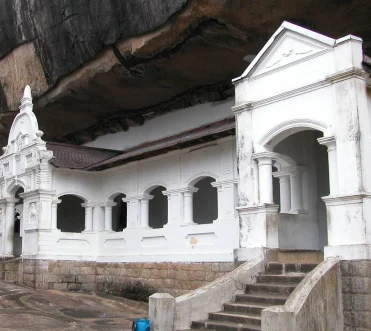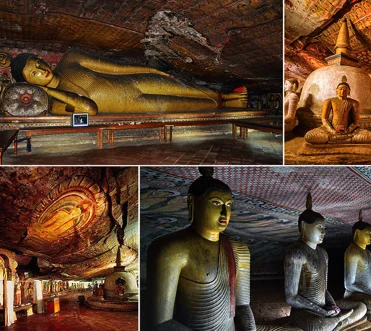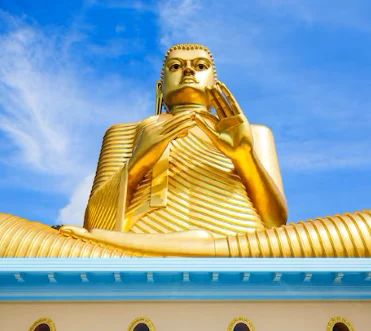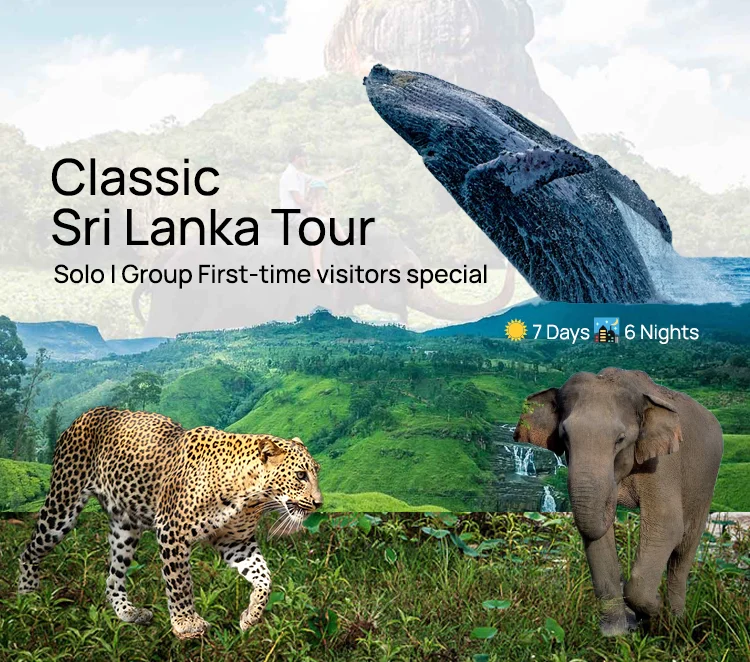Exploring Dambulla Cave Temple: Sri Lanka’s Largest Rock Temple

Complex
Located in the heart of Sri Lanka’s Cultural Triangle, the Dambulla Cave Temple, also known as the Golden
Temple of Dambulla, is a UNESCO World Heritage Site and the largest, best-preserved cave temple complex in Sri Lanka. This ancient rock temple rises 160 meters above the surrounding plains and consists of five main caves, richly adorned with over 150 Buddha statues and mural paintings that date back to the 1st century BCE.
Highlights of the Temple Complex
The Five Sacred Caves of Dambulla Cave Temple
Cave 1 – Devaraja Lena (Cave of the Divine King)
- Main Feature: A massive 14-meter reclining Buddha statue carved directly from the rock.
- Significance: Represents the Buddha in his final moments before attaining Parinirvana (final nirvana after death).
- Additional Details: At the feet of the reclining Buddha is the statue of Ananda, his devoted disciple, weeping in sorrow. A small statue of Vishnu is also found here, believed to have protected the cave complex.
- Ambiance: Serene and quiet, this cave sets the tone for spiritual introspection.
Cave 2 – Maharaja Vihara Lena (Cave of the Great Kings)
- Main Feature: The largest and most impressive cave in the complex.
- Size: About 52 meters wide, 23 meters deep, and 7 meters high.
- Buddha Statues: Houses 56 Buddha statues, including seated, standing, and reclining forms.
- Murals: Walls and ceilings are covered in vivid Kandyan-style frescoes illustrating key scenes from the Buddha’s life and Jataka tales.
- Royal Presence: Contains statues of King Valagamba (who developed the caves in the 1st century BCE) and King Nissanka Malla (12th century), who later contributed to the temple.
- Sacred Relic: A small stupa enshrined within the cave further enhances its spiritual atmosphere.
Cave 3 – Maha Alut Vihara (Great New Temple)

- Era: Built during the Kandyan period in the 18th century.
- Murals: Features elaborate murals in vibrant colors with distinct Kandyan influence, more recent than those in Cave 2.
- Statues: Contains 50 Buddha statues, including a beautifully preserved seated Buddha and several smaller images.
- King’s Statue: Statue of King Kirti Sri Rajasinha, under whose patronage the cave was renovated.
- Ambiance: A fusion of classical and more modern Buddhist art, showing the evolution of devotion and aesthetics.
Cave 4 – Pachima Viharaya (Western Temple)
- Size: Smaller than the previous caves, but spiritually significant.
- Main Statue: Features a seated Buddha under a Makara Thorana (mythical arch).
- Interior: Simpler interior with a modest stupa and small collection of Buddha statues.
- Feel: Quiet, intimate space ideal for contemplation.
Cave 5 – Devana Alut Viharaya (Second New Temple)
- Era: The most recent addition, possibly dating to the 18th or 19th century.
- Materials: Unlike other caves, many statues here are made from brick and plaster, not rock.
- Highlights: A large reclining Buddha and several smaller statues of deities and monks.
- Visual Style: Brighter, more contemporary painting styles reflect later periods of temple use.
Summary Table
| Cave | Name | Key Features | Notable Elements |
|---|---|---|---|
| 1 | Devaraja Lena | 14m Reclining Buddha | Ananda statue, Vishnu |
| 2 | Maharaja Vihara | 56 Buddha statues, murals | Kings Valagamba & Nissanka |
| 3 | Maha Alut Vihara | Kandyan murals, 50 Buddhas | King Kirti Sri Rajasinha |
| 4 | Pachima Viharaya | Seated Buddha, small stupa | Makara Thorana |
| 5 | Devana Alut Viharaya | Brick/plaster statues | Reclining Buddha, newer style |
You can book your tour with Lanka Tour Driver to enjoy the venu, Check our Packages
The Golden Buddha Statue – Dambulla
Location:
- Situated at the base of the Dambulla Cave Temple complex, just before the stairway leading up to the ancient caves.
- It’s part of the Golden Temple of Dambulla, a UNESCO World Heritage Site.
Description:
- This colossal seated Buddha statue is one of the tallest Buddha statues in Sri Lanka, measuring 30 meters (98 feet) in height.
- Crafted in golden hue, it represents the Dhammachakka Mudra, the posture of teaching the first sermon.
- The Buddha sits on top of a massive golden stupa-like structure with a lion’s mouth as the main entrance to the museum below.
Architectural Features:
- Built in 2001, the statue combines modern Buddhist architecture with traditional symbolism.
- It sits atop the Dambulla Buddhist Museum, which is shaped like a traditional temple pavilion and decorated with bright colors and intricate motifs.
- The entire structure reflects a blend of Sri Lankan craftsmanship and Buddhist iconography, symbolizing the preservation of the Theravāda Buddhist tradition.

Symbolism:
- The Dhammachakka Mudra (Wheel of Dharma gesture) signifies the first sermon of the Buddha in Sarnath, making it a powerful icon of wisdom and teaching.
- Its golden color signifies enlightenment, purity, and divine spiritual energy.
Visitor Experience:
- You can walk up to the statue’s base, admire its intricate details, and enjoy panoramic views of the surrounding landscape.
- Photogenic spot – Ideal for iconic travel photos and spiritual reflection.
- Entrance to the museum is through the lion’s mouth, symbolizing protection and strength.
Travel Tips for Visitors:
- Best time to visit: Early morning or late afternoon to avoid heat and crowds.
- Dress modestly: As it is a religious site, wear clothing that covers shoulders and knees.
- Footwear: You must remove your shoes when entering the temple premises.
- Bring water and sun protection: The stairway up to the cave temples can be hot and exposed.
- Photography: Allowed in outdoor areas, but avoid using flash inside the caves and respect signs.
Is the Golden Buddha Statue in Dambulla made of real gold?
No, the Golden Buddha Statue at Dambulla is not made of solid gold. It is a plated or painted structure designed to resemble gold.
What it’s actually made of:
- The statue is constructed using concrete and steel as its structural base.
- It is then coated with a golden paint or gilded finish, giving it the shiny and luminous golden appearance.
- The intention is symbolic — to represent the purity, divinity, and enlightenment of the Buddha.
Why it looks like gold:
- The gold color is deeply symbolic in Buddhism. It reflects:
- Wisdom and enlightenment
- Royalty and sacredness
- The Buddha’s radiant aura
Frequently Asked Questions
What is special about Dambulla Cave Temple?
It’s Sri Lanka’s largest and best-preserved rock cave temple with over 150 Buddha statues and ancient murals.
How old is Dambulla Cave Temple?
The temple dates back to the 1st century BCE, making it over 2,000 years old.
What should I wear when visiting these sacred temples?
Modest attire is recommended. It’s advisable to wear clothing that covers shoulders and knees as a sign of respect.
Are there entrance fees?
Yes, foreign visitors must pay an entry fee (approx. $7–10 USD). Locals may enter free.
How long does a visit take?
You’ll need about 1.5 to 2 hours to explore all five caves comfortably.
By following these guidelines, you’ll not only show respect for Sri Lanka’s sacred places but also enrich your own experience of these timeless spiritual treasures. Enjoy your journey through Sri Lanka’s hallowed halls of worship – it’s sure to be as enlightening as it is unforgettable!




